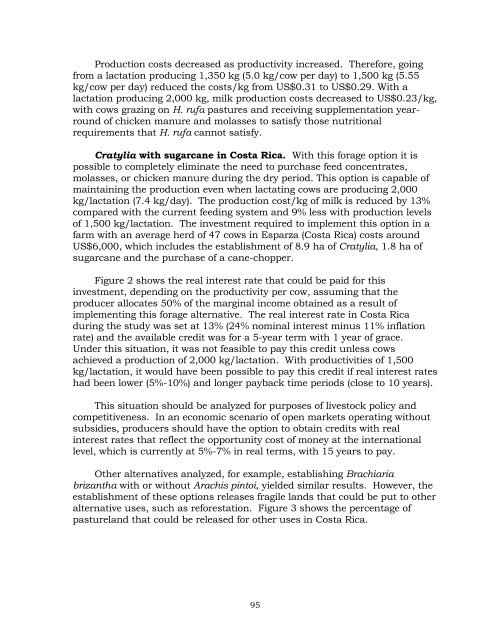Feeding Systems with Legumes to Intensify Dairy Farms - cgiar
Feeding Systems with Legumes to Intensify Dairy Farms - cgiar
Feeding Systems with Legumes to Intensify Dairy Farms - cgiar
You also want an ePaper? Increase the reach of your titles
YUMPU automatically turns print PDFs into web optimized ePapers that Google loves.
Production costs decreased as productivity increased. Therefore, going<br />
from a lactation producing 1,350 kg (5.0 kg/cow per day) <strong>to</strong> 1,500 kg (5.55<br />
kg/cow per day) reduced the costs/kg from US$0.31 <strong>to</strong> US$0.29. With a<br />
lactation producing 2,000 kg, milk production costs decreased <strong>to</strong> US$0.23/kg,<br />
<strong>with</strong> cows grazing on H. rufa pastures and receiving supplementation yearround<br />
of chicken manure and molasses <strong>to</strong> satisfy those nutritional<br />
requirements that H. rufa cannot satisfy.<br />
Cratylia <strong>with</strong> sugarcane in Costa Rica. With this forage option it is<br />
possible <strong>to</strong> completely eliminate the need <strong>to</strong> purchase feed concentrates,<br />
molasses, or chicken manure during the dry period. This option is capable of<br />
maintaining the production even when lactating cows are producing 2,000<br />
kg/lactation (7.4 kg/day). The production cost/kg of milk is reduced by 13%<br />
compared <strong>with</strong> the current feeding system and 9% less <strong>with</strong> production levels<br />
of 1,500 kg/lactation. The investment required <strong>to</strong> implement this option in a<br />
farm <strong>with</strong> an average herd of 47 cows in Esparza (Costa Rica) costs around<br />
US$6,000, which includes the establishment of 8.9 ha of Cratylia, 1.8 ha of<br />
sugarcane and the purchase of a cane-chopper.<br />
Figure 2 shows the real interest rate that could be paid for this<br />
investment, depending on the productivity per cow, assuming that the<br />
producer allocates 50% of the marginal income obtained as a result of<br />
implementing this forage alternative. The real interest rate in Costa Rica<br />
during the study was set at 13% (24% nominal interest minus 11% inflation<br />
rate) and the available credit was for a 5-year term <strong>with</strong> 1 year of grace.<br />
Under this situation, it was not feasible <strong>to</strong> pay this credit unless cows<br />
achieved a production of 2,000 kg/lactation. With productivities of 1,500<br />
kg/lactation, it would have been possible <strong>to</strong> pay this credit if real interest rates<br />
had been lower (5%-10%) and longer payback time periods (close <strong>to</strong> 10 years).<br />
This situation should be analyzed for purposes of lives<strong>to</strong>ck policy and<br />
competitiveness. In an economic scenario of open markets operating <strong>with</strong>out<br />
subsidies, producers should have the option <strong>to</strong> obtain credits <strong>with</strong> real<br />
interest rates that reflect the opportunity cost of money at the international<br />
level, which is currently at 5%-7% in real terms, <strong>with</strong> 15 years <strong>to</strong> pay.<br />
Other alternatives analyzed, for example, establishing Brachiaria<br />
brizantha <strong>with</strong> or <strong>with</strong>out Arachis pin<strong>to</strong>i, yielded similar results. However, the<br />
establishment of these options releases fragile lands that could be put <strong>to</strong> other<br />
alternative uses, such as reforestation. Figure 3 shows the percentage of<br />
pastureland that could be released for other uses in Costa Rica.<br />
95
















